Abstract
Wind energy development has been limited by concerns associated to the varying features in wind speed which tends to destabilize the power system. This study aims to clarify the variability of winds within a day in the Philippines, specifically the hourly changes of onshore horizontal winds at 100-m hub-heights. A whole one-year experiment using the Weather Research and Forecasting model shows that onshore wind speeds decrease during the transitional hours between land breeze and sea breeze. The decreases in wind speed are most significant over coastal regions with high sloping topography. The extreme decreases in wind speed during morning hours, due to the natural processes, are found to often occur at the same time as the extreme electricity undersupply caused by the morning increase in energy demand. This result warns that the power system stability in the Philippines may become more sensitive to the variability of wind as the share of wind energy generation increases in the future. The findings of this study can contribute to promote sustainability in the operation of existing wind-reliant power systems and planning of future wind energy developments.
1. Introduction
In the last decade, wind energy development has been seen to rise all over the world. With this rise, the reliability of electricity has been threatened in different countries that have a significant amounts of variable renewable energy (VRE) generation (e.g., wind and solar) in their power systems. It is because of this threat to the reliability that understanding the fluctuations in wind energy generation has become one of the priorities of not only power system or grid operators, but also research [,]. In the Philippines, the reliability issues associated to the integration of more wind energy generation in the power system has not been explored through previous studies. Previous studies on renewable energy in the country [,] have been focused on quantifying wind energy potentials and somewhat creating a wind energy atlas. This lack of studies in this field is mostly because the amount of wind energy in the power system is not so significant.
The small amount of wind energy developments in the country relative to its demand is influenced by the economics and policies surrounding these developments. Currently, wind energy costs are larger compared to other sources of energy. It is for this reason that the Philippine government opted to implement a Feed-In-Tariff (FIT) system in the past, for a limited number of megawatt-capacities to promote the growth of renewable energy in the country. As the capacity for FIT had been filled out, wind energy development had slowed down, if not stopped. Along with the economics of this development, the Philippine government has also recently released the Renewable Portfolio Standard (RPS) policy, which requires electricity distributors to source at least thirty percent of their energy from renewable sources by the year 2030. As the economy and policies pave the way for more wind energy generation in the next few years, the importance of the reliability issues associated to its variability also increases.
The main problem of variability are the fluctuations in production that can lead to large, unexpected and sudden increases and decreases in power output over a short period, which are known as wind ramp events []. Wind power ramp events are mainly caused by the large fluctuations of wind speed that affect the load-generation balance at all times. Since wind ramp events increase the instability of the power grid, they must be balanced by other power sources. Understanding the timing or magnitude of ramp events can thus help grid operators to schedule the wind power output conservatively. Generally, atmospheric circulation is important to understand wind power ramps and the associated energy resources as they affect the statistics of near-surface wind speeds [,]. Some previous works focused on studying the occurrence of wind ramps by using numerical weather prediction models (e.g., []) since they can provide relatively accurate representations of wind power generation (e.g., [,]). They found that the growth of the planetary boundary layer (PBL) can be one of dominant factors of ramp events.
Generally, atmospheric mixing brought by the development of the boundary layer affects the changes of wind speeds within the day, altering the wind profile [,,]. Aside from these locally occurring factors, hourly variability within a day can also be affected by synoptic-scale events. Previous studies of wind variability such as that by He et al. [] analyzed the wind speeds at different heights within an hourly time scale. Their research found that wind speeds generally had a strong decrease within the morning and consequently increased later in the morning. They suggested that these were caused by changing pressure patterns between land and the sea. Therefore, diurnal variation of wind speeds can be strongly affected to reliability of the power system in coastal regions and islands like Philippines. Moreover, the diurnal variation of surface wind manifests large amplitude over the tropical regions []. However, despite the present situation, the link between the diurnal variation of winds in the tropical island area and reliability of the power system is still poorly understood.
Hence, this study aims to understand the variability in wind energy generation which is strongly dependent on how wind speeds behave. Due to the lack of temporally and spatially well-distributed wind speed datasets at heights used for wind energy, hourly wind speeds are quantified and analyzed using the Weather Research and Forecasting (WRF) model. From the analyses, the mechanism behind the hourly wind speed trends within a day are investigated. The wind speed trend is compared with the reliability of the power system within the same timescale. Based on the analysis of WRF experiments and power stability data, this study suggests the possibility that the timing of extreme decrease in wind speed (i.e., naturally caused wind ramp) coincides with the timing of extreme undersupply of electricity that is caused by anthropogenic effects. This study is intended to provide an insight into how the Philippine power system needs to be developed to cater for an increased amount of wind energy generation expected in the future.
2. Methodology
Hourly wind speeds in the Philippines are simulated using the WRF model version 4.1 [] for the whole one year of 2017. Wind simulations from the WRF model are most sensitive to the physics schemes [,] and the model’s grid settings []. Hence, the analyzed wind speeds are obtained from the mean of an ensemble of five simulations with varying surface layer (SL) and planetary boundary layer (PBL) schemes. These schemes vary on how they compute the unknowns in turbulent patterns using known variables within the model grids []. A list of these schemes, generally varying in the locality of how they solve for thermal fluxes (i.e., local or non-local closure), is provided in Table 1. Siebesma et al. [] provided a description of the differences in solving between these closure types. As for the grid settings, a twenty-kilometer grid resolution is only used due to the large domain size and the limited computational resources for this study. Given that the analysis is the generalization over a big area (i.e., over the entire Philippine region), the grid size is reasonable.

Table 1.
Surface layer and PBL schemes used for the one-year wind simulations.
The ERA-Interim reanalysis [] is used as the boundary conditions in running the regional model. ERA-Interim is a database of atmospheric and surface data from the European Centre of Medium-Range Weather Forecasts (ECMWF). It has a spatial horizontal resolution of 0.75 by 0.75 degrees spacing, roughly 79 km, and a temporal resolution of 6 h []. Previous studies [,] suggest that ERA-Interim provides the most reliable results when it comes to simulating wind speeds for RE resource. The rest of the settings and parameterizations are based on the University Corporation for Atmospheric Research’s best practices [].
For each of the simulations, the domain indicated in Figure 1 with 150 × 150 grid points, is used. The Philippine region belongs to tropical rainforest or tropical monsoon climates. The domain is vertically divided into 40 layers whose thickness increases with height ranging from 25 m at the lowest layer to 622 m in the middle troposphere. Wind speeds are obtained at 100 to 2500-m heights above ground level with an interval of 100 m by vertical interpolation. Individual 36-h simulations are made with the first 12 h of the simulations removed (Figure 2) to account for spin-up []. The remaining 24 h are stitched together to create one-year wind speed simulations for each of the ensemble members through post-processing. In the studied area, diurnal cycle is a dominant mode of the wind variability. Hence, our main results described in Section 3 (i.e., the timing and the magnitude of wind speed change) are expected to be valid for other years.
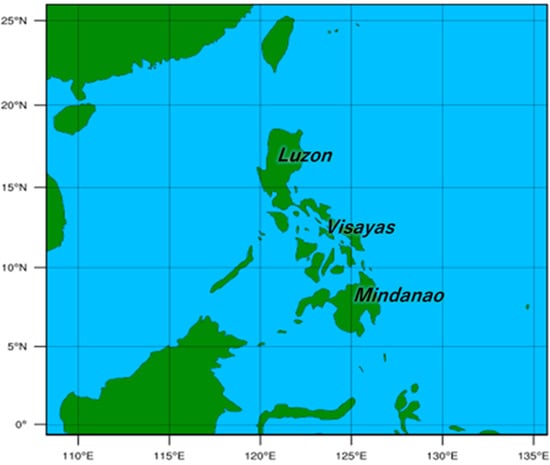
Figure 1.
Simulation domains for the one-year wind simulations.
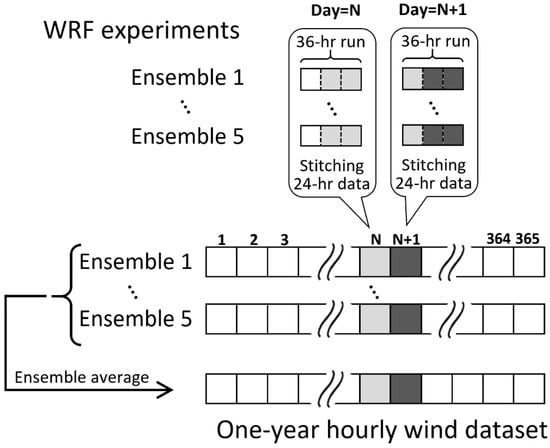
Figure 2.
A flow chart summarizing the experiment and analysis procedures.
As for the analysis of the impact of the variability of wind speeds to the reliability of the power system, within a 24-h period, the hourly frequency of occurrences of extreme hourly changes is first obtained to represent the hourly occurrences of extreme wind speed change. These are then compared to the reliability of the power system which is represented by the hourly frequency of occurrences of the extreme oversupply and undersupply of energy within the day, obtained from the Philippine grid operator []. These occurrences of oversupply and undersupply of energy cause disruptions to the stability, and overall threaten the reliability of the power system. The hourly diurnal frequencies for both the extreme wind speed changes and energy oversupply and undersupply are obtained by binning the 5% extremes into their respective hours of the day.
3. Results and Discussions
The results of this study are divided into two parts: the meteorology behind the variability of diurnal hourly wind speeds in the Philippines, and the hourly relationship between the extremes of the wind variability and the stability of the power system in the country.
3.1. Hourly Variability in the Philippines within a Day
To understand the general hourly trends of wind speeds within a day in the region, the ensemble mean wind speeds of each hour of the day are first computed from the one-year simulations. The area-average of wind speeds over land is then calculated from the average of all the land surface grid points inside the area 4.25–20.59° N, 116.28–126.80° E. The obtained diurnal hourly mean wind speed at 100 m above ground level is seen in Figure 3. At night, winds appear to be stable as seen by the small magnitude of hourly changes (black bars) denoting the existence of the stable boundary layer. The stable boundary layer then evolves into a turbulent mixed layer as evidenced by the sharp increase in the magnitude of hourly wind changes at 0700 local time which lasts during the day.
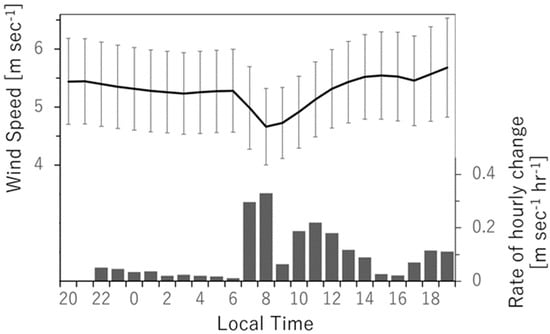
Figure 3.
Diurnal cycle of area-averaged annual means of hourly 100m-height onshore wind speeds (black solid line) obtained from the mean of ensemble members. Error bars and black bars represent the range of standard deviation among the ensemble members and magnitude of the hourly change of the wind speed, respectively. The hourly changes are computed by the previous hour subtracted from the current hour.
Since updrafts and downdrafts coexist within this mixed layer, decrease or increase in wind speed magnitudes is depending on the height [] as seen in Figure 4. A significant decrease in 100-m winds is seen at 0800 in the morning and had rapidly developed. After that, the winds then increased, showing a magnitude greater than those in the evening for a couple of hours on the same level as the decrease propagated into the upper atmosphere. These increases and decreases in the different levels of the atmosphere ultimately result in the vertical homogenization of wind speeds near the surface. After the sunset, near-surface winds below 200 m are decoupled with the winds in the residual layer above that height. Near surface winds remain almost unchanged throughout early morning as the surface stable layer is capped by the nocturnal inversion layer. Figure 3 and Figure 4 suggest that the time evolution of onshore wind speed is asymmetrical between sunrise and sunset hours.

Figure 4.
Vertical cross-sections of area-averaged annual means of hourly onshore wind speeds (contours; m/s) and its hourly changes (shaded) obtained from the ensemble mean. The hourly changes are computed by the previous hour subtracted from the current hour. The horizontal axis represents the local time while the vertical axis represents the height in meters.
To further explain the evolution of the boundary layer, specifically focusing on the strong decrease in wind speeds at 0800 in the morning, the vertical potential temperature gradients over land are analyzed which provide information on the static stability of the atmosphere. The area-averaged annual means of the hourly vertical potential temperature gradients and vertical wind speeds can be seen in Figure 5. The hourly changes of potential temperature gradient show a rapid increase in near-surface temperature at the beginning of the development of the mixed layer as the sun rises (Figure 5). Right before sunrise, there exists a thin surface layer created from the strong static stability during the night. This strong static stability is identified through the large positive vertical potential temperature gradient at 0600 in Figure 5. As the sun rises, this thin layer of air can easily be heated which can rapidly increase surface temperatures. This rapid increase in temperatures can be seen during the morning, in this case at the 0700 and 0800. Kimura and Kuwagata [] quantified the heating of these layers from the surface up to 3500 m over a mountainous terrain through numerical modeling. Their results also showed rapid increases in surface heating relative to elevations above the surface in the morning. As the surface layer became thicker due to the development of the mixed layer, the heating rate gradually decreased. The development of the boundary layer, however, does not explain why wind speeds eventually became largest early in the afternoon then showed a decrease later in the afternoon, followed by an increase. This trend is investigated by first looking at the spatial distribution of the hourly change (i.e., increases and decreases) in wind speeds shown in Figure 6. During the transitions between daytime and nighttime, the wind directions over the coastal regions appear to change, most significantly over the west side or the lee of the dominant wind flow in the Philippines. During the day, winds blow from the sea to the land, while at night, the winds blow from land to sea. These changing wind directions paired with the changing magnitude of wind speeds over coastal regions suggest coastal meteorological mechanisms that may modulate the variability of wind speeds in the Philippine archipelago.
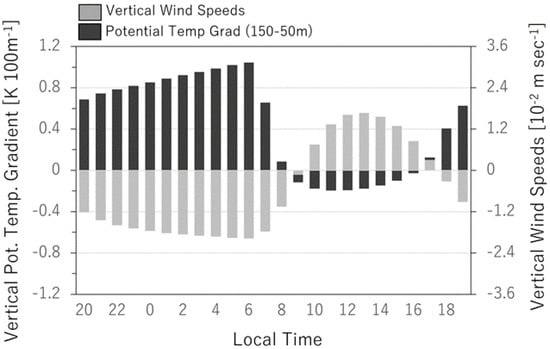
Figure 5.
Area-averaged annual mean diurnal variation of the vertical potential temperature gradient (black bars) between 50 and 150 m above ground level and vertical velocity (grey bars) at 100 m above ground level.
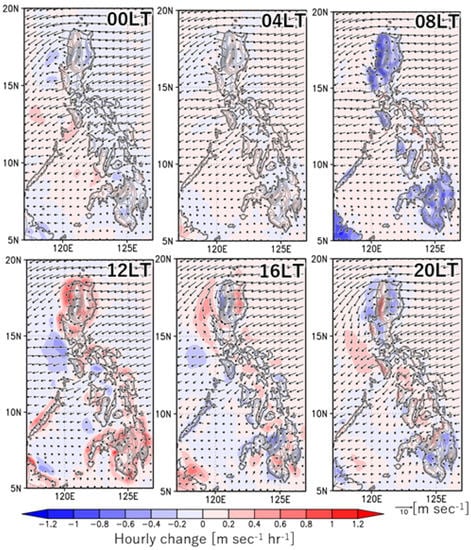
Figure 6.
Spatial distribution of mean hourly change of wind speeds (shaded; m/s/h) and the direction of the hourly mean winds (vectors) at every four-hour interval. The hourly changes are computed by the previous hour subtracted from the current hour.
Due to the differences between heat capacities between land and sea, temperature differences are formed between them. This thermal contrast drives the land–sea breeze circulation which accompanies the changing directions of wind. The role of the land–sea breeze is also deduced through the magnitudes of hourly wind speeds. During the transition hours between land breeze and sea breeze, pressure difference between land and sea is reduced in response to the weakening of horizontal temperature gradients which then weakens the horizontal wind speeds. As the transitions occur during sunrise and sunset, signs of weakening horizontal wind speeds over the surface can be seen in Figure 3 during the 0800 and 1800 LT. After these transitions, a more pronounced horizontal pressure gradient between land and sea generates an increase in the horizontal wind speeds. This increase peaks around the early afternoon, signifying that the difference between land and sea surface temperatures are the highest. The largest difference in surface temperature between land and sea, which results as higher horizontal pressure gradients, happen during the day as seen in Figure 7, because of the heat capacity differences between land and sea that were discussed earlier. This explains why the magnitude of wind speeds is larger during the day than at night. However, because the coverage of the area used for the potential temperature differences in Figure 7 is vast and irregular, it will not perfectly represent the potential temperature gradient between land and sea. Nonetheless, it provides an idea of how significant the temperature differences are between night and day.
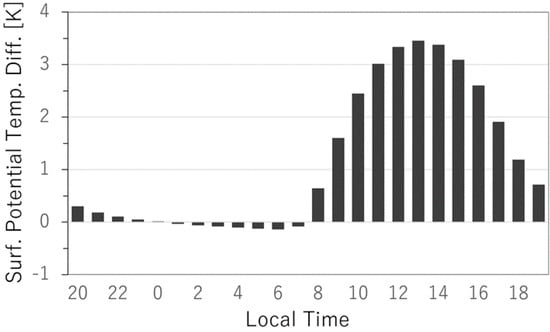
Figure 7.
Differences in area-averaged potential temperatures at 100 m above the surface between land and sea over the region indicated in Figure 6.
The evolution of the planetary boundary layer and the development of land–sea breeze within a day comprise the two thermal processes, whose combined effects modulate the diurnal hourly changes of wind speeds in the Philippines. Results show that the magnitude of their effects on horizontal wind speeds may be of the same scale based on how the signs of these trends are seen in the overall diurnal cycle of the annual mean of hourly wind speeds. These processes, aside from affecting the wind speeds, may also affect each other. As land–sea circulations are dependent on the horizontal pressure gradients that exist between land and sea, these circulations are dependent on the surface heating. The hourly changes of this surface heating, in turn, are dependent on the evolution of the boundary layer. As the evolution of the boundary layer dictates the amount of mixing that exists in the atmosphere which later affects the layer thickness, horizontal pressure gradients are modulated. The opposite may also be true. During the day, updrafts may be enhanced by the transport and condensation of moisture by the sea breeze, releasing latent heat, and increasing the static instability in the region [].
Aside from thermal processes, mechanical processes produced from the region’s landscape may also play a role in the hourly changes of diurnal wind. To analyze the impact of the landscape on the hourly changes of diurnal winds, the relationship of the topography of archipelago’s islands to the changes in the diurnal wind speeds are discussed. High hourly changes in wind speeds are found over regions with complex topography (Figure 6). The relationship between complex topography and hourly changes appears to be most significant over the coastal regions in the lee of the archipelago. Being at the lee of the archipelago, background flow is reduced, allowing location specific processes to have a more significant effect. These local specific processes may be the land–sea breeze circulation.
As the weak sea breeze blows a little after sunrise, the mountains in the region may decrease the flow on its windward side. At 1200, strong increases in wind speed are found at sea over coastal regions, indicating possible downdrafts that compensate for the updrafts coming from the mixed boundary layer on land. As the horizontal pressure gradient is reduced in the afternoon, significant reductions in horizontal wind speeds are again found at 1600 over these mountain regions. Within these regions of complex topography in coastal regions, gap jets [] exist. Given that wind energy development has often been associated to wind energy potentials that are represented by the magnitude of winds in an area, variability of winds over these regions may have been neglected. This neglect can result to later problems in keeping the stability of the power system to be discussed in the following section.
3.2. The Hourly Relationship between the Extreme Wind Variability and the Stability of the Power System
As the total fraction of wind energy generation continues to increase, extreme wind events, specifically its change, has become a growing concern for the efficient and secure operation of national power systems [,,]. For this reason, the spatial and temporal variability of extreme wind changes (ramp evets) all over the Philippine archipelago are analyzed in the study. The positive (negative) extreme change in the wind speeds is described as a “ramp up (ramp down)”. A histogram of hourly changes in wind speeds over all the grid points can be seen in Figure 8. To account for the maximum wind changes over the study region the upper and lower extreme events of hourly changes were analyzed. Using the 5th and 95th percentiles of wind speed changes or extreme wind changes in Figure 8 for ramp down and ramp up events, respectively, frequency in terms of the total number of events is binned depending on the local time at which they occurred (Figure 9). The occurrence of the extreme ramp-down events is commonly found at 0800 in the morning. This implies that, within a year, extreme decreases in wind speeds generally occur at that time given that the area-averaged annual means of hourly wind speed change also showed a decreasing trend at this hour. A similar trend is seen in the 1% and 0.1% percentiles of extreme wind speed changes (not shown). Having the same time of occurrence may mean that these extreme hourly changes in wind speed are caused by the same mechanisms described in previous section. Aside from the hourly occurrence of these ramp events, the spatial distribution of these extreme ramp events is also identified. Figure 10 shows the hourly spatial distribution of the 0.1% most extreme ramp-down events while Figure 11 shows the spatial distribution for the same percent extreme of ramp-up events. From the results, the extreme ramp events mostly happen over coastal regions and places with complex topography, further validating that these extremes occur due to the mechanisms discussed in the previous section. As complex topography appears to be only simulated within the islands of Luzon and Visayas, the extreme events only occur in those regions of the Philippines. Another reason will be geographical factors, such as coastal shape and size of the island, that modulate the timing and the magnitude of the extreme wind changes.
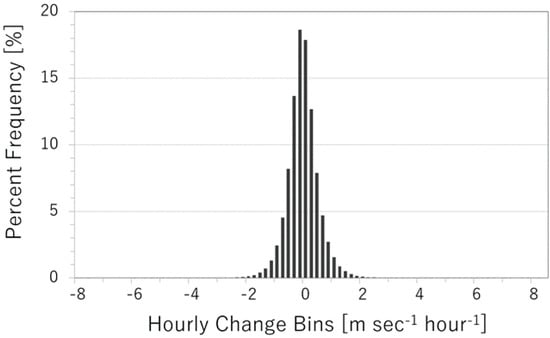
Figure 8.
Percent frequency of the hourly changes in one-year 100-m onshore wind speed for all the horizontal grid points.
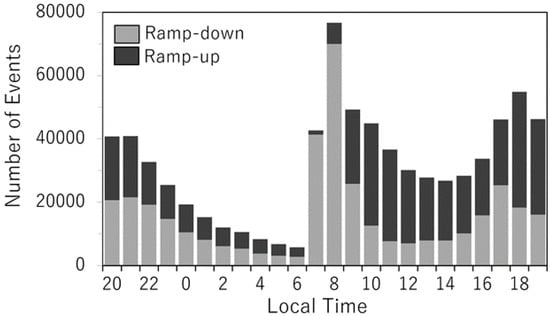
Figure 9.
The annual number of occurrences of the 5% most extreme ramp-down events (grey bars) and ramp-up events (black bars) of wind speeds for each hour of a day.
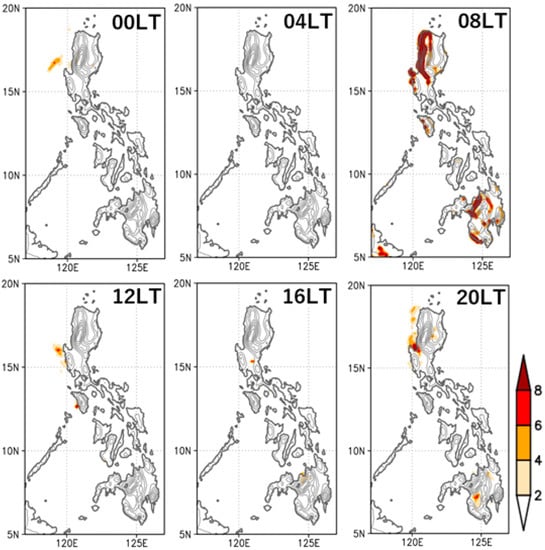
Figure 10.
Spatial distribution of hourly frequency of the 0.1% most extreme ramp-down events at each grid point (shaded). The contours indicate terrain heights (100-m intervals).
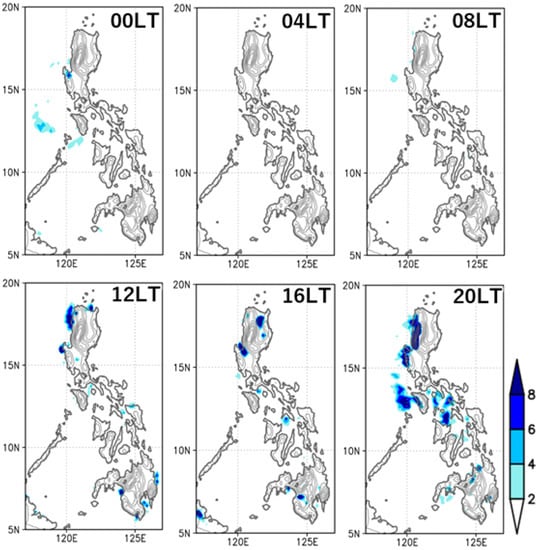
Figure 11.
The same as Figure 10 but for ramp-up events.
These extreme hourly ramp events are then compared with the extreme oversupply and undersupply events at an hourly timescale within a day. For this study, the total number of 5% most extreme undersupply and oversupply events within each diurnal hour is obtained from FirstGen and PEMC [] and shown in Figure 12. Extreme wind ramp down events are expected to coincide with the hours of the extreme undersupply of energy while extreme ramp-up events are expected to occur at the same hour as extreme oversupply. In Figure 12, except for the 0800, extreme oversupply and undersupply events seemingly occurred randomly within the diurnal cycle and did not appear to match the results of the extreme wind ramp events.
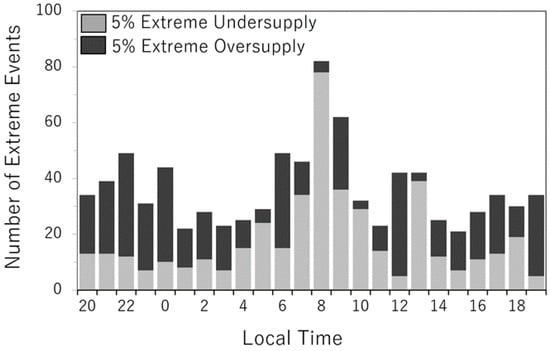
Figure 12.
The annual number of occurrences of the 5% most extreme undersupply events (grey bars) and oversupply events (black bars) of wind speeds for each hour of a day.
Although the occurrence of extreme undersupply events and the extreme ramp-down of winds coincide within the same hour, the extreme undersupply is found not to be caused by the extreme ramp-down of winds. Two factors are considered on which the extreme oversupply and undersupply of energy is dependent on: (1) the magnitude of the extreme wind ramp event, and (2) the total capacity of wind energy in the region. Comparing the hourly energy demand and the consumed wind energy, wind energy consumption only accounts for barely 2% of the total demand of the system []. This means that any changes in wind generation, even if it were a complete decrease, would not have equated to any impact to the stability of the grid system. Even if the winds are to completely reduce (i.e., 100% decrease), the system will remain unaffected due to this decrease only accounting for a small portion of the system. Within the system, there exists the ancillary generators which aim to compensate for the variability of VRE. Hydropower has been used to manage this variability, especially in small VRE reliant power systems []. In 2014, the Philippines was reported to have a total installed hydropower capacity of 5461 megawatts [], more than 10 times the current capacity of wind power.
Analyzing the demand of the entire system, extreme increases and decreases in the demand are also summed within the diurnal hours. The expected trend is that extreme decreases in demand occur in the same hour as extreme oversupply of energy, while extreme increases in demand occur together with extreme undersupply of energy. This trend in Figure 13 is consistent, mostly in the morning at around 0800 and 0900. These extreme increases in demand may be associated to the usual behavior of the society wherein people begin utilizing energy as the day begins. The results also find that there was an extreme decrease in demand during 1700 which is often the last hour of work within the Philippine working society. The next decreases in demand occur as the day comes to an end from 2000 to 0100 the following day.
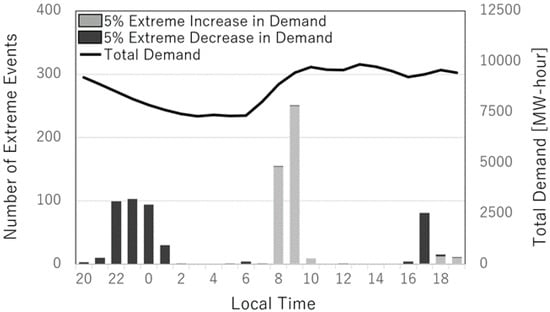
Figure 13.
Sub-daily variation of extreme increase and decrease events in the energy demand. The bar graphs represent 5% of the extreme changes in demand of energy events binned within their respective hours. The line graph shows the annual mean hourly energy demand.
These findings show two significant details about the Philippine power system. The first is that the grid operator has currently been unable to anticipate the behavior of the society when it comes to energy use. This is understandable given that human behavior changes in time, although certain trends and statistics such as those presented in this study may be analyzed. The second is that, although given the current capacity of renewable energy within the whole grid system is low, it can be expected that this will also increase in time, given international and environmental pressures to create a low carbon society. As wind energy development increases the share of wind power generation in the Philippines, the country’s system may become more vulnerable to the variability or intermittency of wind energy. Forecasting variability of both VRE resources and the demand may play a more crucial role in years to pass.
4. Conclusions
Due to looming threats due to climate change, wind energy, together with solar and other forms of renewable energy have grown in popularity as a source of energy to mitigate these threats. The Philippines, despite being the pioneer of large-scale wind energy development in Southeast Asia, through its utilization of wind energy dating back to 2004, has seen a slow increase in its renewable energy capacity relative to its rising demand. This slow increase has been due to the variability and intermittency of wind resources, together with economic and political factors. This variability, without the proper weather and demand forecasting, and infrastructure that can keep-up with the rapid increases and decreases of VRE resources, can generate problems with the stability and reliability of the grid. Although these problems exist, wind energy development considerations have mostly been focused on the energy potentials, and not necessarily the variability. Within the next few years, because of changes in policies and the economics of the wind energy market, wind energy development is expected to increase. With this increase in wind energy developments, the increase in the adverse impacts brought by its variability raises the question on the sustainability of these developments. For these reasons, this study attempted to quantify the hourly variability of wind speeds during one whole year in the Philippines using a mesoscale numerical model, WRF. The quantified hourly variability, specifically its hourly changes, were compared to the hourly disturbances in the stability of the country’s power system.
The diurnal cycle of annual mean wind speeds was found to have small hourly changes at night. In the morning, a strong decrease in wind speeds was found at 0800. Increases were then seen to follow this strong decrease. As the sun sets, wind speeds were once again seen to decrease but not as significant as the decrease recorded during sunrise. Analyses of wind changes and other variables showed that over land thermal and mechanical processes affect wind flow in the Philippine archipelago. The thermal processes regulate the evolution of the mixed and stable boundary layers and the development of land–sea breeze. Thermal processes alone may not have generated the extreme changes in the winds. These however, initialized the impact of mechanical processes caused by the landscape of the region, that led to the significant hourly changes in wind speeds. These mechanical processes were seen spatially in how these hourly changes occurred over regions with complex topography or those with varying terrain heights near the coastline. Temporally, the significant hourly changes happened during the transitions between day and night, at which transitions between the mixed and stable layers, and land breeze and sea breeze occur.
Upon looking at the occurrence of the extreme hourly changes of wind speed from 5% of the most extreme events of hourly changes, the study found that there was a high frequency of extreme decreases in wind speeds at 0800, signifying the possibility that the mechanism which generally drives diurnal winds is also causing the extreme changes in wind speed. To check the impact of this variability on the stability of the power system, extreme oversupply and undersupply of energy events were obtained on an hourly basis. Results showed that there is often a significant undersupply of energy at 0800 in the morning, coinciding with the extreme decreases in wind speed at the same time. Given that wind energy production accounts only for barely 2% of the entire demand, this undersupply is unlikely to have been caused by the extreme decreases in wind speeds. Extreme changes in demand, specifically its increase over that hour appears to be the reason for the undersupply extremes. The existence of undersupply events becomes problematic as the capacity of wind energy within grid systems is expected to rise. As the total share of generation from wind energy in the power system increases, the stability of the system becomes more sensitive to the intermittency of the atmosphere. By 2030, the total installed wind capacity for the world is projected to significantly surpass the total renewable energy capacity back in 2016 [], showing the world’s predicted reliance on wind energy as a significant energy resource. The interdisciplinary connections in view of meteorology and energy science in this study highlight possible future concerns. A better understanding of the physical mechanism of hourly wind variation is expected to help improve the forecast of the wind power ramp. A synergistic use of accurate predictions of VRE generation and energy system modeling, with consideration of their uncertainties, ensures the stability of power systems.
Finally, we propose two issues as the subjects of future studies. Firstly, the COVID-19 and related policy decisions have altered the human lifestyle, which could affect the diurnal cycle of electricity demand. Future studies are expected to address this issue. Secondly, aside from the short-range wind ramps studied here, the “windless” periods, that sometimes lasts more than ten days, called “dark doldrums” are also the subject of intensive study. This phenomenon can cause the possibility of energy supply disruption under high VRE penetrations. In order to provide more accurate statistics of wind speed and its fluctuations in this time range, the analysis of longer-term wind variability will be essential in future studies.
Author Contributions
Conceptualization, methodology, K.R.E.L., T.S. and M.O.; software, K.R.E.L. and T.S.; validation, K.R.E.L., T.S. and M.O.; investigation, resources, formal analysis, data curation, writing—original draft preparation, K.R.E.L.; writing—review and editing, T.S. and M.O.; visualization, K.R.E.L. and T.S.; supervision, project administration, and funding acquisition, T.S. All authors have read and agreed to the published version of the manuscript.
Funding
This research was funded by Grants-in-Aid for Scientific Research (KAKENHI) Grant Number 19H05666 and the Integrated Research Program for Advancing Climate Models (TOUGOU) Grant Number JPMXD0717935561 from the Ministry of Education, Culture, Sports, Science and Technology (MEXT), Japan.
Acknowledgments
This work was carried out under the Innovative Asia program supported by the Japan International Cooperation Agency (JICA).
Conflicts of Interest
The authors declare no conflict of interest.
References
- Engeland, K.; Borga, M.; Creutin, J.D.; François, B.; Ramos, M.H.; Vidal, J.P. Space-time variability of climate variables and intermittent renewable electricity production—A review. Renew. Sustain. Energy Rev. 2017. [Google Scholar] [CrossRef]
- Archer, C.L.; Colle, B.A.; Delle Monache, L.; Dvorak, M.J.; Lundquist, J.; Bailey, B.H.; Beaucage, P.; Churchfield, M.J.; Fitch, A.C.; Kosovic, B.; et al. Meteorology for coastal/offshore wind energy in the United States: Recommendations and research needs for the next 10 years. Bull. Am. Meteorol. Soc. 2014, 95, 515–519. [Google Scholar] [CrossRef]
- Elliott, D. Philippines Wind Energy Resource Atlas Development. In Business and Investment Forum for Renewable Energy and Energy Efficiency in Asia and the Pacific Region; National Renewable Energy Laboratory: Golden, CO, USA, 2000; pp. 1–10. [Google Scholar]
- NREL; USAID. Greening the grid: Solar and wind grid integration study for the Luzon-Visayas system of the Philippines. Altern. J. 2018, 27, 30–35. [Google Scholar]
- Marquis, M.; Wilczak, J.; Ahlstrom, M.; Sharp, J.; Stern, A.; Smith, J.C.; Calvert, S. Forecasting the wind to reach significant penetration levels of wind energy. Bull. Am. Meteorol. Soc. 2011, 92, 1159–1171. [Google Scholar] [CrossRef]
- Cutler, N.J.; Outhred, H.R.; MacGill, I.F.; Kepert, J.D. Predicting and presenting plausible future scenarios of wind power production from numerical weather prediction systems: A qualitative ex ante evaluation for decision making. Wind Energy 2012, 15, 473–488. [Google Scholar] [CrossRef]
- Klink, K. Atmospheric circulation effects on wind speed variability at turbine height. J. Appl. Meteorol. Climatol. 2007, 46, 445–456. [Google Scholar] [CrossRef]
- Deppe, A.J.; Gallus, W.A.; Takle, E.S. A WRF ensemble for improved wind speed forecasts at turbine height. Weather Forecast. 2013, 28, 212–228. [Google Scholar] [CrossRef]
- Drew, D.R.; Cannon, D.J.; Brayshaw, D.J.; Barlow, J.F.; Coker, P.J. The impact of future offshore wind farms on wind power generation in Great Britain. Resources 2015, 4, 155–171. [Google Scholar] [CrossRef]
- Cannon, D.J.; Brayshaw, D.J.; Methven, J.; Coker, P.J.; Lenaghan, D. Using reanalysis data to quantify extreme wind power generation statistics: A 33 year case study in Great Britain. Renew. Energy 2015, 75, 767–778. [Google Scholar] [CrossRef]
- Wallace, J.M.; Hobbs, P.V. Atmospheric Science: An Introductory Survey, 2nd ed.; Academic Press: Amsterdam, The Netherlands, 2006. [Google Scholar] [CrossRef]
- Hancock, P.E.; Zhang, S. A wind-tunnel simulation of the wake of a large wind turbine in a weakly unstable boundary layer. Bound. Layer Meteorol. 2015, 156, 395–413. [Google Scholar] [CrossRef]
- Pena, A.; Rethore, P.-E.; Rathmann, O. Modeling large offshore wind farms under different atmospheric stability regimes with the Park wake model. Renew. Energy 2014, 70, 164–171. [Google Scholar] [CrossRef]
- He, Y.; Monahan, A.H.; McFarlane, N.A. Diurnal variations of land surface wind speed probability distributions under clear-sky and low-cloud conditions. Geophys. Res. Lett. 2013, 40, 3308–3314. [Google Scholar] [CrossRef]
- Sato, T.; Miura, H.; Satoh, M.; Takayabu, Y.N.; Wang, Y. Diurnal cycle of precipitation in the tropics simulated in a global cloud-resolving model. J. Clim. 2009, 22, 4809–4826. [Google Scholar] [CrossRef]
- Skamarock, W.C.; Klemp, J.B.; Dudhia, J.; Gill, D.O.; Liu, Z.; Berner, J.; Wang, W.; Powers, J.G.; Duda, M.G.; Barker, D.M.; et al. A Description of the Advanced Research WRF Version 4; NCAR Tech. Note NCAR/TN-556+STR; National Center for Atmospheric Research: Boulder, CO, USA, 2019. [Google Scholar] [CrossRef]
- Carvalho, D.; Rocha, A.; Gómez-Gesteira, M.; Silva Santos, C. Sensitivity of the WRF model wind simulation and wind energy production estimates to planetary boundary layer parameterizations for onshore and offshore areas in the Iberian Peninsula. Appl. Energy 2014, 135, 234–246. [Google Scholar] [CrossRef]
- Fernández-González, S.; Martín, M.L.; García-Ortega, E.; Merino, A.; Lorenzana, J.; Sánchez, J.L.; Rodrigo, J.S.; Sanchez, J.; Valero, F. Sensitivity analysis of the WRF model: Wind-resource assessment for complex terrain. J. Appl. Meteorol. Clim. 2018, 57, 733–753. [Google Scholar] [CrossRef]
- Smith, E.N.; Gibbs, J.A.; Fedorovich, E.; Klein, P.M. WRF model study of the Great Plains low-level jet: Effects of grid spacing and boundary layer parameterization. J. Appl. Meteorol. Clim. 2018, 57, 2375–2397. [Google Scholar] [CrossRef]
- Stull, R.B. An Introduction to Boundary Layer Meteorology; Springer: Dordrecht, The Netherlands, 1988. [Google Scholar] [CrossRef]
- Siebesma, A.P.; Soares, P.M.M.; Teixeira, J. A combined eddy-diffusivity mass-flux approach for the convective boundary layer. J. Atmos. Sci. 2007, 64, 1230–1248. [Google Scholar] [CrossRef]
- Dee, D.P.; Uppala, S.M.; Simmons, A.J.; Berrisford, P.; Poli, P.; Kobayashi, S.; Andrae, U.; Balmaseda, M.A.; Balsamo, G.; Bauer, D.P.; et al. The ERA-Interim reanalysis: Configuration and performance of the data assimilation system. Q. J. R. Meteorol. Soc. 2011, 137, 553–597. [Google Scholar] [CrossRef]
- Dee, D.P.; Balmaseda, M.; Balsamo, G.; Engelen, R.; Simmons, A.J.; Thépaut, J.N. Toward a consistent reanalysis of the climate system. Bull. Am. Meteorol. Soc. 2014, 95, 1235–1248. [Google Scholar] [CrossRef]
- University Corporation for Atmospheric Research (UCAR). NAMELIST.INPUT: Best Practices. WRF Users Page. Available online: https://www2.mmm.ucar.edu/wrf/users/namelist_best_prac_wrf.html (accessed on 18 April 2021).
- Ulmer, F.-G.; Balss, U. Spin-up time research on the weather research and forecasting model for atmospheric delay mitigations of electromagnetic waves. J. Appl. Remote Sens. 2016, 10, 16027. [Google Scholar] [CrossRef][Green Version]
- FirstGen; Philippine Electric Market Corporation (PEMC). Philippine Power System Data: Hourly System Demand, Dispatched Energy, and System Frequency for 2017; PEMC: Manila, Philippines, 2019. [Google Scholar]
- Kimura, F.; Kuwagata, T. Horizontal heat fluxes over complex terrain computed using a simple mixed-layer model and a numerical model. J. Appl. Meteorol. Climatol. 1995, 34, 549–558. [Google Scholar] [CrossRef][Green Version]
- Gierach, M.M.; Graber, H.C.; Caruso, M.J. SAR-derived gap jet characteristics in the lee of the Philippine Archipelago. Remote Sens. Environ. 2012, 117, 289–300. [Google Scholar] [CrossRef]
- Ohba, M.; Nohara, D.; Kadokura, S. Impacts of synoptic circulation patterns on wind power ramp events in East Japan. Renew. Energy 2016, 96, 591–602. [Google Scholar] [CrossRef]
- Martínez-Lucas, G.; Sarasúa, J.I.; Sánchez-Fernández, J.A. Frequency regulation of a hybridwind-hydro power plant in an isolated power system. Energies 2018, 11, 239. [Google Scholar] [CrossRef]
- Mondal, M.A.H.; Rosegrant, M.; Ringler, C.; Pradesha, A.; Valmonte-Santos, R. The Philippines energy future and low-carbon development strategies. Energy 2018, 147, 142–154. [Google Scholar] [CrossRef]
- IRENA. Future of Wind: Deployment, Investment, Technology, Grid Integration and Socio-Economic Aspects (A Global Energy Transformation Paper). 2019. Available online: https://www.irena.org/-/media/Files/IRENA/Agency/Publication/2019/Oct/IRENA_Future_of_wind_2019.pdf (accessed on 18 April 2021).
Publisher’s Note: MDPI stays neutral with regard to jurisdictional claims in published maps and institutional affiliations. |
© 2021 by the authors. Licensee MDPI, Basel, Switzerland. This article is an open access article distributed under the terms and conditions of the Creative Commons Attribution (CC BY) license (https://creativecommons.org/licenses/by/4.0/).